Deborah J. Ross's Blog, page 150
March 14, 2012
Kay Kenyon on recovering enthusiasm for a story that's stalled

Leonid Pasternak, 19th C.
Kay Kenyon, who is one of my favorite writers-on-writing (as well as a fine novelist in her own right) describes a situation many of us have faced. I'd say "all," except there might be a lone exception somewhere out there in Writerland.
Sooner or later in your writing life you are going to run up against a novel that just won't spark to life. Technically the story appears to have all the needed aspects, but as a whole, it is less than the sum of its parts. The characters don't engage, the plot wanders, and your beta readers are unmoved.
She suggests that the best strategy might be to not work harder. I talk a lot about being tender with yourself, especially when it comes to creative endeavors. Continuing to push, to flog ourselves, keeps us locked with whatever is blocking us in the first place. We often do better when we step back, take a deep breath, refresh the creative well, work on something else. Kay says:
Trying to write when you're discouraged or tired might seem like a brave thing to do–and if you are often discouraged or tired, it is brave to keep on–but in most cases it's a bad idea to flog yourself until you get back at the project.
Sometimes taking a few week's break is not only good for your mental health, it can do wonders for your novel rewrite. Work on a short story or an essay. Pile up some reserve blog posts. Don't be idle, but don't work on the problem project.
There is an almost magical power you can tap into when you let your manuscript sit for two weeks or a month. It is called perspective. Perspective is what you lose when you've been too close to your novel, especially if you've read the draft a number of times either aimlessly fussing with style or remodeling the story arc.
The rest of the article is well worth reading.

Published on March 14, 2012 09:50
March 13, 2012
A New Anthology: Beyond Grimm: Tales Newly Twisted
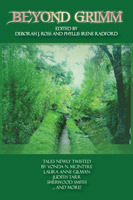
First of all, a Happy Editor dance... [dance, dance, dance]
This is the first anthology I've edited (actually, co-edited with Phyllis Irene Radford) for Book View Cafe. It began, lo these many many months ago, with an in-house discussion along the lines of "Hey, wouldn't it be fun to..." Book View Cafe has already published several anthologies (Rocket Boy and the Geek Girls, Dragon Lords and Warrior Women -- which has a story of mine! -- The Shadow Conspiracy I and II), so there was some precedent. We knew to ask things like, Will this be reprint, original stories, or both? Will it be a benefit for BVC or will the authors receive shares of the proceeds? How will we define the theme? At a certain point, we'd reached a sufficient level of enthusiasm and clarity so that someone had to put on an organizational (aka editor's) hat.
Thinking this would be marvelous fun, I volunteered, and the way it worked out, Phyl co-edited it with me. I supplied time and my own editorial experience, and she had the expertise of working with the BVC anthology publication procedures. Because there were two of us, we could submit our own stories to one another, thereby avoiding the editing-your-own-work scenario.
One of the things I love about editing anthologies is watching the process, the landscape of that adventure, unfold, discovering moments of truth and hilarity and heart-wrenching sadness and sheer beauty and poetry in prose. Beyond Grimm was no exception. Although we started with "let's retell classic fairy tales," our imaginations took us in other directions as well - the sun-drenched islands of Greek mythology, legends from the frozen north, Arthurian tales, nursery rhymes, even my own riff on the plots of classical ballets. Fairy-tale lands, contemporary urban settings, magical and not-so-magical steeds, spells and epistles of the people's revolution, mysterious locked chambers and shape-shifters...moonlight and storms.
Here's the blurb:
Not your grandmother's fairy tales...
From
the far-ranging imaginations of Book View Café authors comes this
delirious collection of classic tales newly twisted into dark,
dangerous, and occasionally hilarious re-tellings. From the golden isles
of Greece to the frozen north, from fairytale castles to urban slums,
join us on an unforgettable journey!
And....drum roll....
The Table of Contents...
Through Forests Dark and Grimm...
Hair Raising, by Pati Nagle
No Newt Taxes, by Patricia Rice
Rum Pelt Stilt's Skin, by Alma Alexander
Of Rats and Cats and Teenagers, by Irene Radford
Tinderbox, by Maya Kaathryn Bohnhoff
Any Brave Boy, by Laura Anne Gilman
Across Golden Seas...
Elfleda, by Vonda N. McIntyre
Harpies Discover Sex, by Deborah J. Ross
To Serve A Prince, by
Brenda Clough
The Rapture of Ancient Danger, by Sherwood Smith
In Another Part of the Forest...
Mending Souls, by Judith Tarr
Sister Anne, by Sylvia Kelso
Princess Dancer, by Sue Lange
Nimuë's Tale, by Madeleine E. Robins
Ricky Cowlicky, by Maya Kaathryn Bohnhoff
Little Red in the Hood, by Irene Radford
Around A Campfire...
Hero/Monster, by Amy Sterling Casil
To Ride Beyond the Wide World's End, by Judith Tarr
Turnabout, by Deborah J. Ross
Secrets Unveiled... [this last part is author bios, every bit as delightful and fanciful as the stories they contributed!]
Here's where to buy it, for only $4.99.
The cover photo was taken by my husband, Dave Trowbridge, and is the maze in our back yard.

Published on March 13, 2012 12:06
March 6, 2012
GUEST POST Madeleine E. Robins on Regency Romance
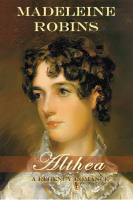
I wrote Althea, my
first book, because I needed something to read.
I think most readers know that feeling: you look around wanting a
particular something and you cannot,
in that moment, find it. What I wanted
was more Georgette Heyer, new Heyer;
but Miss Heyer had recently died, and there would be nothing new from her any
more.
I discovered Georgette Heyer's books in high school, and
read her entire oeuvre, including her
medieval books and her mysteries; what I really loved were her Georgian and
Regency romances. They were witty and sparkling
and filled with nifty sense of the time and place, and unlike most of the
period fiction I had stumbled over up to that time, they weren't Victorian; call it aesthetic preference or just
cussedness--the Victorians don't speak to me.
But the Regency, as depicted by Heyer, was bright and frothy and
delightful.
Then I encountered Jane Austen, and fell into an entirely
different and deeper love; Austen writes of love and money but without Heyer's fascination
with the nobility of the nobility (virtually none of the titled characters in
Austen are admirable). Austen is deadly
funny, observant, and firmly rooted in a real time and place (my favorite line
in Sense and Sensibility comes at the
end, when the heroine and her husband are so happy that "they had in fact nothing to wish for, but the
marriage of Colonel Brandon and Marianne, and rather better pasturage for their
cows."). I went through a
brief period where my passion for Austen kind of spoiled Heyer for me. But I got better.
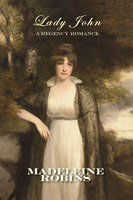
And I became curious about the Regency. I knew there was a Prince Regent, but I
wasn't really clear why, or why it mattered, or why there was a whole period
named for him. So in college I took
courses in English history, and started reading around, and a whole world
opened up to me. The Regency has everything. Okay, I suppose all periods
have everything--heaven knows the Georgian and Victorian eras on either side of
the Regency had plenty going on. But the
Regency has the Napoleonic Wars, the Romantic poets, famine, the rise of
enclosure, new science, new technology, a burgeoning middle class, the
beginnings of a police force in London, a shift in attitudes from the passion rationality
of the Enlightenment to a more romantic sensibility that would eventually find
its peak of sentimental expression with the Victorians. What's not to love?
So what was the Regency?
George III was still king, but had been afflicted off and on with a
disease (it is thought to have been porphyria) which made him periodically
irrational. He had had one severe bout
of madness in 1788, but recovered. In
the first decade of the 19th century he began to slide into insanity again; he
was in his sixties (the average life expectancy in England 1800 was 40), half
blind, and now mad. Asking the heir to
the throne to be regent--to act in his father's place--seems like a
no-brainer. But there were politics,
both familial and national, that got in the way (I have a great sympathy for the man who would become George IV) and despite the
King's infirmities, it wasn't until March of 1811 that a Regency bill was
passed in Parliament and the Prince of Wales became the Prince Regent.
Technically, then, the Regency lasts from 1811 to 1820, when
George III died and the Regent became George IV. But for purposes of Heyer, and my own Regency
writing, I'd say it's more like 1795-1825.
In costuming terms, roughly from the rise of the Empire silhouette and a
more informal, more relaxed style (related very directly to the rise of the
Romantic movement) to the beginnings of that odd top-heavy broad-shouldered look
in the 1820s.
In terms of manners, the Regency is a fascinating mid-point
between the earthier manners of the 18th century and the fetishistically
refined manners of the Victorians. But
even with the more relaxed standards of the Regency, one thing did not change:
the place of, and expectations of, women of the middle and upper classes. Marriage was a tool for the preservation of
property; it was virtually the only career open to a woman of good family; and
if a woman had little money or property to bring with her, she'd damned well
better bring virginity and a pristine reputation.
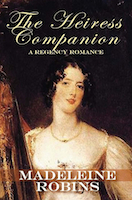
Austen and Heyer both, in their own ways, focus on
this. The rules and penalties were
understood, and it was only a very naive woman, or a very privileged woman, or
a remarkably strong-minded woman, who went against them. It is hard for modern audiences to understand
how devastating it is to the Bennet family when Lydia elopes with Wickham in Pride and Prejudice: not only does Lydia
cast her own "virtue" aside; she calls into question the upbringing,
moral fiber and marriageability of her sisters as well, and her sisters must marry or be reduced to grinding
genteel poverty. Heyer, who places most
of her characters in the nobility or upper tiers of society, seems more concerned
with the social costs of misbehavior or eccentricity. Austen (who writes from her experience as an
unmarried gentlewoman) knows just how precarious a woman's situation could
be--she concerns herself with the clash between the need for money and the desire
to love one's mate.
The older I get, the more interested I am in this stuff:
convention and the punishments for transgression. In writing Point of Honour, the first of my Sarah Tolerance books, I wanted to
take a woman of good family who had (rashly) thrown away her virtue, and find a
way for her to survive in a Regency society, unlikely to marry but unwilling to
become someone's mistress or a prostitute.
Fusing noir mystery with Jane Austen (with a dash of Heyer) let me do
that, and situate my stories in a London that is grittier and more dangerous
than anything in either Austen or Heyer.
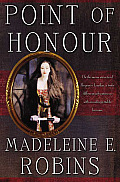
But when I wrote that first book I wanted glitter. I wanted froth. I wanted the glitz and pleasure
of dazzling ballrooms and gorgeous clothes and being able to think of the
perfect rejoinder before the other
person leaves the room, and the comfort of an uncomplicated happy ending. Much as I love Austen, when I wrote my first
book I wanted Heyer's Regency. Thirty
years later, I still think that's a perfectly reasonable thing to want.
From Deborah: You can find Madeleine's delicious Regency Romances at Book View Cafe or Powell's bookstore online

Published on March 06, 2012 12:16
February 27, 2012
The Feathered Edge: A Woman Warrior and The Horned King

"The Woman Who Fell In Love With The Horned King" is the second story with a woman warrior-as-champion/paladin. One of the most interesting things about putting together these anthologies of romantic, swashbuckling fantasy (2 volumes of Lace and Blade, and now The Feathered Edge: Tales of Magic, Love, and Daring) is the synchronicity -- or parallelism -- or "great minds work alike" thematic resonances. The first had 2 stories about Spanish highwaymen, the second 2 stories with Chinese generals. I'm not in the least surprised, but I am delighted and a bit awestruck by the way life works. The cover for The Feathered Edge could illustrate either this story or Sean McMullen's "Culverelle." You get to pick.
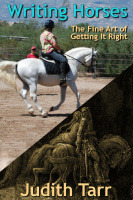
Now to the story. No, wait, background! I've loved Judith Tarr's work since I picked up A Wind In Cairo when it first came out. The horse got me into the book, as I'm a sucker for well-written horse characters, but the sheer mastery of storycraft, the depth and nuance, the use of language, all kept me wanting more. None of this should come as a surprise. Judy knows more about horses than any ten fantasy writers put together, and what she doesn't know, one or another of her nine amazing Lipizzan horses will enlighten us about. She's written the best guide to horses in writing I've ever seen, Writing Horses; The Fine Art of Getting It Right, and if you are a writer and need a horse in your story, it's a must-read.
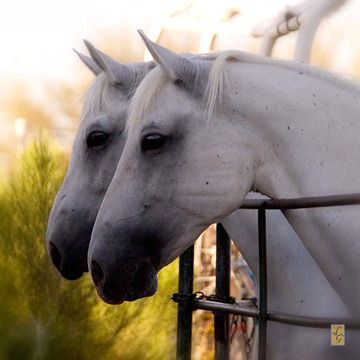
Capria and Khepera
The other thing about Judy's work is that her careful attention to detail -- the kind of detail not for detail's-sake but that evokes a vivid world beyond the page -- carries over to historical background, culture, world-building, and character. You can read a sampling of her short work free on Book View Cafe here.I've never read anything of hers that's remotely generic, even when it falls solidly within a genre. Her "Alamut" books were among the first to portray Muslim cultures in a positive, yet humanly complex way.
One of the self-indulgent luxuries of editing is being able to contact the writers-of-my-dreams and say, "Hey, want to come play?" It takes a certain amount of chutzpah, it does. So I asked. Judy said yes, and sent me this wonderful, sweeping, heroic tale that reminds me of the best of the women-martial-arts stories from Marion Zimmer Bradley's Sword & Sorceress series. Judy's heroine is no bronze-bikini-clad superwoman, but a character set firmly within her world, with hopes and disappointments and family obligations, cognizant of both her strengths and her limitations. And The Horned King, oh my! You'll just have to read to the story...
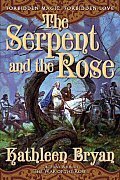
If "The Woman Who Fell In Love With The Horned King" leaves you, like me, wanting more, rejoice! It's set in the world of The Serpent And The Rose, under the pseudonym of Kathleen Bryan.
The beautiful photo of Capria and Khepera is by Lynne Glazer, used with permission. See more of her work here:

Published on February 27, 2012 10:38
February 22, 2012
Now in print...

The Feathered Edge: Tales of Magic, Love, and Daring is now available as a trade paperback. It's up on Amazon - don't see it elsewhere yet. Should make it to bookstores in a week or two.
If you enjoy it, please post a brief review!

Published on February 22, 2012 18:00
February 21, 2012
Winter reading - some very cool books
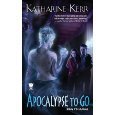
I'm an unabashed fan of Katharine Kerr's "Nola O'Grady" series. The third, Apocalypse To Go,
lives up to its predecessors in inventiveness, drama, romance, and
whimsy. In this urban fantasy, the heroine works for a supernatural
Agency "so secret, the CIA doesn't know it exists". This takes place in
an alternate San Francisco, one in which magic and the clandestine
agencies necessary to regulate it are real. This world is not the only
one; there are alternate, weirdly dystopic worlds (and a gateway in the
attic of Nola's aunt's house). Not only do the Agency and its people
hide in plain sight, Nola's family, Irish illegal immigrants with past
ties to the IRA, live with secrets, low on the radar. In this newest
novel, we not only explore the radioactive San Francisco from previous
episodes, but we encounter yet another world, one in which the dominant
intelligent race is feline in origin, leopard to be precise. Apocalypse To Go
definitely builds on the previous two books, but Kerr offers enough
toe-holds so that it can serve as an entry point. Readers should be
warned, however, that the series is addictive.
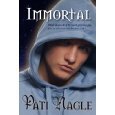 Winter
Winterbrings storms, and storms mean power outages. Here in the mountains,
these often go on for days. Most years, our generator kicks in and we
continue on as before. This year, however, through a series of
mechanical failures, we suffered through a period without electricity.
Fortunately, there are many wonderful things to do that do not require
it. Walking the dog, playing the piano, snuggling by candle light.
Reading…as long as it's daytime. All of which is a roundabout way of
saying how glad I was that I'd loaded Pati Nagle's Immortal on
my (fully-charged) netbook computer. As the forest darkened, I pretended
I was on vacation and curled up in my favorite chair.
On the surface, Immortal resembles other teen romances —
girl meets unbelievably handsome and mysterious boy; throbbing hearts
ensue. But Nagle's heroine is no hapless Bella, she's a college student
with a job, a car, and a mind of her own. Nor is the gorgeous guy an
angsty vampire, although he definitely is not one of your usual folk.
The plot moves briskly from encounter to threat to road trip to battle, a
fine way to spend a couple of winter nights. In the end, the story is
as much about how relationships help us to determine the direction of
our own lives as it is about hormones. That's what sets this YA novel
apart.
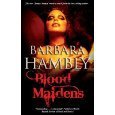 If
Ifyou're nauseated by sparkly, angst-ridden teenage vampires, and you
like your dark suspense with wit and political savvy, check out Blood Maidens,
the third in Barbara Hambly's turn-of-the-century vampire novels. It's
as much mystery as it is adventure or spy novel or horror, both
fast-paced and literate. It stands well on its own, although the
previous two are highly recommended.
Hambly's vampires are neither sparkly nor nice. They're dark and
dangerous, and on the eve of World War I, the Kaiser would very much
like to enlist them as his agents. Not that this is any concern of the
vampires themselves, existing as they do in their own separate, hidden
world, one in which even the pleasures of the mind eventually wear away
into apathy. (One of the most poignant images in the novel is a
once-beloved harp, so long disused that its stings have turned to rust.)
Enter James Asher, ex-British spy and former uneasy and unwilling ally
of the Renaissance vampire, Don Simon Ysidro. Asher's search for
Ysidro's missing friend takes him to St. Petersburg, from its daylight
fads for the supernatural and spiritualism, fueled by Rasputin's
utterances, to its nightly contest between two claimants to the mastery
of the vampire population, to a mysterious woman who by all reason must
be a vampire…except she appears in public in daylight. Hambly neatly
connects the belief in spontaneous human combustion to the fate of
vampires exposed to sunlight. One set of questions gives rise to the
next, with the threat of a German-vampire alliance overshadowing the
landscape of Europe, all tempered by Hambly's deft and humane touch.
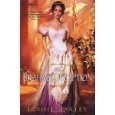 I've
I'vebeen a fan of Louise Marley's work for years now. By a wonderful
coincidence, I had just begun learning the Brahms piano piece, Waltz in A
Flat, when I read The Brahms Deception. For an adult beginner
with small hands, playing Brahms amounts to an exercise that rivals the
most complex yoga postures. The man apparently had immense hands and
wrote music that he could play, refusing to compromise with anyone
else's limitations. Except, apparently, those of the brilliant concert
pianist Clara Schumann. Brahms was hopelessly in love with Schumann, but
biographers do not agree on whether the relationship ever went beyond
the platonic. Here Marley's imagination finds fertile ground as scholars
use time travel for their researches, and an unstable, emotionally
needy music historian enters into the world of Brahms and Schumann…at
the country house where they have a secret tryst. When the historian
does not return as scheduled, a second is sent in search of her. Marley
combines drama, mystery, the perils of time travel and changing history,
and delicious appreciation for the music, artistry and passion of two
immensely gifted musicians. If you don't read science fiction, read this
anyway. If you do read science fiction but don't know anything about
classical music, read it anyway, too.
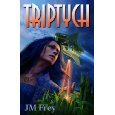 I would never have discovered Triptych,
I would never have discovered Triptych,by J.M. Frey, had I not first met the editor, Gabrielle Harbowy. We
were talking about stories that challenge conventional notions not only
of sexuality but of family, and she mentioned this debut novel by
Canadian J.M. Frey. The cover reveals nothing of the story within — part
queer love story, part alien first encounter story, part time travel
adventure, part mystery, part exploration of polyamory, all laced with
skillfully woven dramatic tension and a sure understanding of the needs
of the human heart.
When aliens come to Earth, they come not as ambassadors or conquerors
but as refugees. They have lost their families and culture as well as
their world. Their species evolved around families of threes — one to
bear children, one to work, one to nurture and protect the others. When a
pair of Earth scientists, also a romantic couple, begin working with
one of the aliens, their own relationship changes. But Earth, for all
its claims of tolerance, is not ready for a marriage that consists of a
man, a woman, and an alien. Not by a long shot.

Published on February 21, 2012 09:56
February 19, 2012
The Feathered Edge: Raven Girl and Sir Francis Drake

Sheila Finch's "Fortune's Stepchild" is linked to other stories backwards-fashion. For so many of us, a tale or legend or bit of history so captured our childhood imaginations that forever after, it is a touchstone for "something wonderful and magic." Kari Sperring, for example, grew up dreaming of joining the musketeers and saving France. (Aside: I wonder if there's something about being British -- Sheila's an ex-pat Brit -- that lends itself to such inspiration; we on the other side of the Atlantic can read about Arthur and company, but he's not our Arthur.) At any rate, Sheila admits to a special fondness for tales about Sir Francis Drake (who was an amazingly colorful fellow, even if only a tenth of the stories told about him are true.)
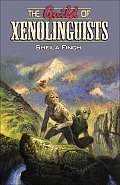
Sheila's best known for her science fiction, including a series of stories about the Guild of Xenolinguists (one of which won the Nebula Award), but she's a writer of many and varied interests. I met her a gazillion years ago, if memory serves me right at the same convention at which I met Sherwood, and thus began a long running conversation. After I fled from Los Angeles to the redwoods of the Central Coast, we'd get together every so often at one convention or another, grab a few friends, and head offsite for the best fish restaurant we could find. And have meaty, thoughtful discussions on everything under the sun.
So when I was considering the balance of new-to-me writers and new-to-my-anthologies writers, I thought, I bet Sheila would come up with something fascinating. With her unerring sense of serendipitous timing, she presented me with a period piece with romance, magic, and intelligence. The first time I read "Fortune's Stepchild," my husband and I had not long finished watching every film adaptation of the life of Elizabeth I we could get our hands on, and my head was filled with the Spanish Armada, Shakespeare, religious wars, courtly politics, schemes and beheadings, pirates and privateers, not to mention seekers of fortune of all varieties.
We tend to think of the early history of the Americas as one tragedy after another, at least for the native peoples. What Sheila has given us is a tiny moment of magic in a land of unusual opportunity. Perhaps this really happened. Perhaps it happened in a different world, a different America.
Perhaps it's one of those stories that should have happened, and some day, in a galaxy far, far away, will...

Published on February 19, 2012 01:00
February 15, 2012
The Feathered Edge: Feathers and Masks

One of the inevitable results of novel writing is that in order to keep the focus on this story (and not the two dozen others that spring up along the way), we have to rein in that natural desire. Myself, I must sometimes bribe secondary characters into staying secondary, by promising them stories of their own, or endowing their appearances with nifty, memorable details. Or virtual chocolate. Then we end up with outtakes, related stories, branching series, and the like. Sometimes, the worlds and casts-of-characters are so vivid and rich, and speak to us so deeply, that we return to them again and again. They provide the setting, background, culture, history for short stories that are complete in themselves, little jewels set in the larger imaginative tapestry.
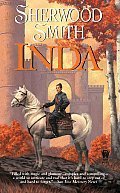
"The Art of Masks," by Sherwood Smith, is one such story. You don't need to have read her Inda series or her many other works set in the world of Sartorias-deles in order to enjoy it. It's simply a slice of a larger world, complex and varied. But if you have, you'll see all the shimmering threads that lead off in the distance. At the first reference to the ballad of Jeje the Pirate Queen, I wanted to stand up and cheer -- it was like glimpsing an old, dear friend, just a flash and then back to the present moment. And yet, the story works just as well if you've never heard of Jeje before. Although you should. You really should.
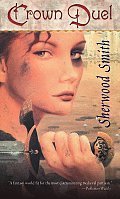
In much the same way, this anthology has links to other works, other stories, and the larger world of fantasy. Sean McMullen's story, "Culverelle," is part of a larger tale, with the same characters. "The Woman Who Loved The Horned King," by Judith Tarr, takes place in a world in which she's already set a trilogy. And "Blue Velvet" is part of Diana E. Paxson's series about the intrepid young Baron Claude DeLorme.
Fantasy literature, like other types, takes on the aspect of a conversation, one I'm especially happy to have with Sherwood. She writes deeply and knowledgeably about a variety of historical and literary topics, and has a gift for encouraging newer writers and generating thoughtful discussions on history, manners, story-telling, and a host of related topics. Even when I feel inundated by things to read -- online and in print -- I find her work rewards a second reading, and "The Art of Masks" is no exception. Every story element is precisely balanced, with an interplay of nuance and detail that enhances the sense of the greater world beyond. The good news is that if you, like me, have fallen in love with that world, there is much much more to discover.
And really, what more can one say about a woman who participates in the SFWA Musketeers, enjoys watching The Three Stooges, and reads the letters of Jane Austen?

Published on February 15, 2012 01:00
February 7, 2012
Murder, the Death Penalty, and Cancer, a personal perspective
Twenty-five years ago, my mother was raped and beaten to death by a teenaged neighbor on drugs. My mother was 70 years old and had been his friend since the time he was a small child. For a long time, I didn't talk much about it except in private situations. This was not to keep it a secret, but to compartmentalize my life so I could function. At first, it was too difficult and then, as the years passed, I refused to let this single incident be the defining experience of my life. Recently, however, I have felt inspired to use my own experience of survival and healing to speak out against the death penalty. I don't write this to convince you one way or another on that particular issue, but to try to illuminate how the two issues are related for me.
My mother's murder was a spectacularly brutal, headline-banner crime, but it was only part of a larger tragedy, for the perpetrator's family had suffered the murder of his older brother some years before. I knew this, but for a long time it didn't matter. My own pain and rage took center stage. But with time and much hard work in recovery, I came to the place of being able to listen to the stories of other people.
We all lose people we love. Tolstoy wrote that happy families are all alike, but every unhappy family is unhappy in its own way. I would interpret that to mean that each loss, each set of relationships and circumstances is unique, but there are things we share.
What might it be like if one family member were murdered -- and another family member had killed someone? What does it feel like to watch the weeks and days pass while the execution of someone you dearly love draws ever nearer? How can we wrap our minds around loving someone and accepting that they have caused such anguish to another family? I've had a chance to talk with people in all these circumstances. It's been a humbling experience.
One thing I have learned over the years is that grief isn't fungible; you can't compare or exchange one person's experience with another's or say, This one's pain is two-thirds the value of that one's. Grief is grief; loss is loss. We cannot truly understand what another's loss is like, especially when it is as devastating and life-altering as the violent death of someone we love. But we can say, "Even though I don't know what you're going through, my heart goes out to you." Whatever our personal story, we can be allies, for surely there is enough compassion, enough tears, enough rage and enough mending of hearts to go around.
I've been on both sides. I believe we have something deep and essential in common -- our broken hearts. Our mending hearts. Our resilient spirits. Our capacity for healing. Our journey through the darkness. I know that I would never, ever want to be part of inflicting what I have endured on another family. I know that life is filled with awful things, and I have faith that kindness lightens grief. I believe all these things are true whether we are the survivors of a murder, victims ourselves, loved ones of perpetrators, or the families of the executed.
What this has to do with cancer is that right now, by the inexplicable way life unfolds, a number of friends -- some of them very close to me -- have been battling various forms of cancer. Here there is no human malice or sudden tragedy, one moment you're fully alive and the next, everything is over. The breakdown of order and health is internal and continues over time. Even in cases where the end comes soon after the diagnosis, it is not instantaneous. You have time, if even a small stretch, to consider your own mortality. And so do those who care for you.
I find I am as angry about the possibility of my friends dying from cancer as I am about losing a loved one to violence. I want to rage at the universe at the unfairness and unfeelingness of it all. I wish there were an old man with a long white beard up in the sky so I could grab him by that beard and let him have a piece of my mind.
I look for someone or something to blame.
In the case of a murder conviction, there is someone to blame. The jury said so or the person admitted it in pleading guilty. In the case of cancer, I don't believe in blaming the victim -- he smoked, she didn't exercise, he ate too many charbroiled steaks and not enough broccoli, she lived near a cellphone tower. Justice demands that we hold those who commit crimes accountable. What do we do with the craving for revenge in our hearts? Or, in the case of cancer, the need to point a finger of blame -- at the patient, at the doctors, at the pharmaceutical companies, at the health insurance carriers.
In neither case will my retaliation bring a loved one back to life or affect the course of a friend's disease. In both cases, I myself become a victim. The impulse to lash out at the responsible person or institution is universal and human. Adrenaline helps us through the early stages of shock and helpless immobility. When it goes on too long, however, it consumes us from within and prevents us from being present in the moment.
I could spend 25 years dedicating my life to ending that of the man who killed my mother. Or I could spend 25 years healing, connecting to life, making the world a better place, writing wonderful stories...being the person she would have wanted me to be.
I could spend the months and years of my friend's cancer in expectant grief and one crusade after another against anything and anyone who isn't finding a cure fast enough. Or I could be present with her, each of us alive at this moment.


My mother's murder was a spectacularly brutal, headline-banner crime, but it was only part of a larger tragedy, for the perpetrator's family had suffered the murder of his older brother some years before. I knew this, but for a long time it didn't matter. My own pain and rage took center stage. But with time and much hard work in recovery, I came to the place of being able to listen to the stories of other people.
We all lose people we love. Tolstoy wrote that happy families are all alike, but every unhappy family is unhappy in its own way. I would interpret that to mean that each loss, each set of relationships and circumstances is unique, but there are things we share.
What might it be like if one family member were murdered -- and another family member had killed someone? What does it feel like to watch the weeks and days pass while the execution of someone you dearly love draws ever nearer? How can we wrap our minds around loving someone and accepting that they have caused such anguish to another family? I've had a chance to talk with people in all these circumstances. It's been a humbling experience.
One thing I have learned over the years is that grief isn't fungible; you can't compare or exchange one person's experience with another's or say, This one's pain is two-thirds the value of that one's. Grief is grief; loss is loss. We cannot truly understand what another's loss is like, especially when it is as devastating and life-altering as the violent death of someone we love. But we can say, "Even though I don't know what you're going through, my heart goes out to you." Whatever our personal story, we can be allies, for surely there is enough compassion, enough tears, enough rage and enough mending of hearts to go around.
I've been on both sides. I believe we have something deep and essential in common -- our broken hearts. Our mending hearts. Our resilient spirits. Our capacity for healing. Our journey through the darkness. I know that I would never, ever want to be part of inflicting what I have endured on another family. I know that life is filled with awful things, and I have faith that kindness lightens grief. I believe all these things are true whether we are the survivors of a murder, victims ourselves, loved ones of perpetrators, or the families of the executed.
What this has to do with cancer is that right now, by the inexplicable way life unfolds, a number of friends -- some of them very close to me -- have been battling various forms of cancer. Here there is no human malice or sudden tragedy, one moment you're fully alive and the next, everything is over. The breakdown of order and health is internal and continues over time. Even in cases where the end comes soon after the diagnosis, it is not instantaneous. You have time, if even a small stretch, to consider your own mortality. And so do those who care for you.
I find I am as angry about the possibility of my friends dying from cancer as I am about losing a loved one to violence. I want to rage at the universe at the unfairness and unfeelingness of it all. I wish there were an old man with a long white beard up in the sky so I could grab him by that beard and let him have a piece of my mind.
I look for someone or something to blame.
In the case of a murder conviction, there is someone to blame. The jury said so or the person admitted it in pleading guilty. In the case of cancer, I don't believe in blaming the victim -- he smoked, she didn't exercise, he ate too many charbroiled steaks and not enough broccoli, she lived near a cellphone tower. Justice demands that we hold those who commit crimes accountable. What do we do with the craving for revenge in our hearts? Or, in the case of cancer, the need to point a finger of blame -- at the patient, at the doctors, at the pharmaceutical companies, at the health insurance carriers.
In neither case will my retaliation bring a loved one back to life or affect the course of a friend's disease. In both cases, I myself become a victim. The impulse to lash out at the responsible person or institution is universal and human. Adrenaline helps us through the early stages of shock and helpless immobility. When it goes on too long, however, it consumes us from within and prevents us from being present in the moment.
I could spend 25 years dedicating my life to ending that of the man who killed my mother. Or I could spend 25 years healing, connecting to life, making the world a better place, writing wonderful stories...being the person she would have wanted me to be.
I could spend the months and years of my friend's cancer in expectant grief and one crusade after another against anything and anyone who isn't finding a cure fast enough. Or I could be present with her, each of us alive at this moment.

Published on February 07, 2012 01:00
February 4, 2012
The Feathered Edge: The Australian Connection
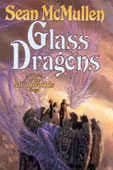
Another of the writers whose work I got to know through the SFWA Circulating Book Plan was Australian Sean McMullen. I think the book was Glass Dragons, the second of his Moonworlds series. It's often challenging to begin a series in the middle, but this one posed no problem. Dragons and vampires and "War of the Worlds" and angsty heroes and radical organizers-of-the-people's-revolution, oh my! Well, not all in that first book, but it was enough to get me hooked.
So a little while later, I wandered into the Tor party at a WorldCon and there was Sean McMullen. I think the introduction caught me by surprise because the first words out of my mouth (after "Hello, I'm Deborah") were, "I love your work!" And received a glorious smile in reply, as if I'd just handed him a precious gift. And yes, it was. We create in such solitude, and reviews are such treacherous things when it comes to "did people like my book? did they understand it?" Then to come all the way to a different continent, to be surrounded by people you've heard of and maybe corresponded with but never met in person, and to have a fellow writer recognize your name and have read -- and remembered -- your work. What a joy!
That conversation was necessarily brief. If you've attended a publisher's party -- or any part -- at a WorldCon, you will understand why. Most communications at large conventions are sound bytes anyway, but when you add a crushing crowd, noise, and alcohol, it's many times so. But Sean and his work kept crossing my path -- we both love cats, we're both martial artists (or I used to be -- 30 years of tai chi and kung fu). By the strange synchronicity of publishing, when I returned to the pages of F & SF with my own work ("The Price of Silence," April/May. 2009), it was to an issue that had a story of Sean's as well.
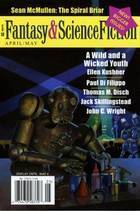
I can take a hint. When I was scheming The Feathered Edge, I wrote to him. We worked together on one story idea, and eventually he sent me "Culverelle." Curiously enough, is set in the same world, with the same overall characters and tale, as "The Spiral Briar" from F & SF. They are not the same stories in that they have different emotional and moral centers, but if you fell in love with Eleanor (as I did), and you savor the wonderful blend of engineering, chivalry, and Faerie, I encourage you to run out and find the other story -- and make a note to look for the novel The Iron Warlock when it's released.
"Culverelle" in some ways belongs to the small but excellent group of stories about women learning to be warriors -- by training. By practicing, by learning what their strengths and weaknesses are and by using those strengths in an intelligent way. (Another example is Barbara Hambly's novel, The Ladies of Mandrigyn.) I love that Sean doesn't simply wave his authorial hands and turn a determined but unfit woman into a super-paladin in a few paragraphs. When we take on such a training, we must be prepared for it to change us in more than physical ways.
Later in the anthology, you'll meet another woman warrior, from Judith Tarr's "The Woman Who Fell In Love With The Horned King." See what you think about what they have in common, and how their experiences are different. As a fascinating side note, the swordswoman on the cover could be either!

Published on February 04, 2012 11:48



